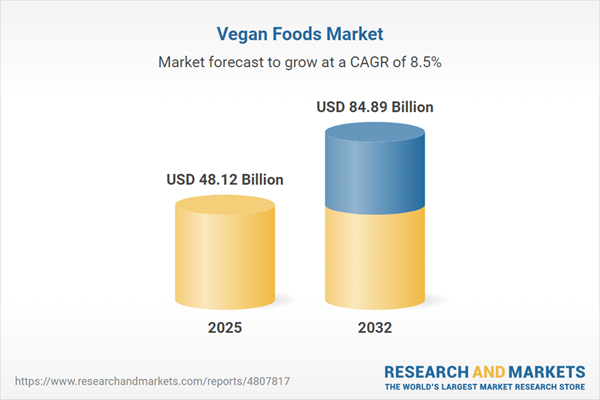Speak directly to the analyst to clarify any post sales queries you may have.
The global vegan foods market is undergoing rapid transformation, shaped by advancing regulations, innovative technologies, and evolving consumer expectations. Senior decision-makers navigating this environment must recognize how these forces create both challenges and new growth opportunities for their organizations.
Market Snapshot: Growth Trajectory in the Vegan Foods Market
The vegan foods market continues to gain momentum, driven by increasing public awareness of health and environmental factors. Demand is broadening across diverse plant-based offerings, and products tailored for ethical sourcing are seeing particular traction. In response, companies are fine-tuning sourcing and global logistics to align with strong consumer interest and evolving regulatory requirements. Adaptive strategies and building robust partnership networks across worldwide markets are essential, as is an emphasis on operational agility. Brands that streamline efficiency and maintain compliance while innovating at scale are better positioned within this highly competitive sector.
Scope & Segmentation of the Vegan Foods Market
This report presents a detailed analysis to support strategic planning, investment choices, and risk management in a complex, rapidly changing vegan foods market. The analysis covers the following critical segments:
- Product Types: Bakery and confectionery, dairy alternatives, meat substitutes, ready meals, and plant-based snacks, addressing a spectrum of dietary needs and fostering ongoing product development.
- Ingredient Sources: Almond, coconut, oat, pea, rice, and soy; using multiple plant-derived inputs supports strong, regionally relevant supply chains and meets local taste demands.
- Meal Occasions: Breakfast, main meals, desserts, and snacks are segmented to connect product development efforts with shifting consumer routines and meal patterns.
- Distribution Channels: Convenience stores, hypermarkets, supermarkets, specialty retailers, direct-to-consumer, and online marketplaces, enabling broad market reach and supporting modern purchasing behaviors.
- End Users: Commercial (foodservice, restaurants, hotels) as well as individual households, requiring tailored marketing and supply approaches for diverse buyer profiles.
- Geographies: Americas, Europe, Middle East, Africa, and Asia-Pacific; each region presents unique regulatory environments and growth trajectories influencing strategy and compliance demands.
- Major Companies: Danone S.A., Nestlé S.A., The Hain Celestial Group, Oatly Group AB, Impossible Foods Inc., Vitasoy International Holdings, SunOpta Inc., Daiya Foods Inc., GoodDot Enterprises, and Schouten Europe B.V. lead the market in innovation and sector standards.
Key Takeaways for Senior Decision-Makers
- Broader product lines in key vegan food categories enable improved alignment with the rising demand for health-focused and sustainable options, building trust and loyalty in both retail and foodservice segments.
- Enhancing production processes and leveraging advanced techniques for plant-based ingredient development helps companies make products more appealing and quickly respond to market demands.
- Synchronizing new product launches with shifts in consumer meal occasions delivers improved market responsiveness and allows for agile adaptation to changing consumption habits.
- Diversifying the supplier network and prioritizing local sourcing strategies reduces exposure to supply chain disruptions while supporting adherence to evolving compliance requirements.
- Directed investment in digital sales channels and targeted online engagement enables companies to access new customer pools, generate timely market insight, and execute adaptive go-to-market plans.
Tariff Impact: Navigating United States Trade Policy Shifts
Recent changes in United States tariff policy are affecting how businesses source critical plant-based ingredients, such as pea protein and coconut. To address this, companies are boosting domestic cultivation and expanding their local processing capacity to support reliable ingredient supply. Additionally, strategic collaborations with international suppliers in favorable trade regions are helping organizations manage procurement risks and safeguard operational stability.
Methodology & Data Sources
Research for this report draws on leading industry publications, authoritative regulatory sources, and executive interviews with procurement and supply chain leaders. Insights and segmentations are validated through cross-reference, ensuring the objectivity and practical relevance required for senior-level strategic decision-making.
Why This Report Matters for Leaders in the Vegan Foods Sector
- Delivers actionable, segmented frameworks to support executive planning, budget allocation, and business development efforts within a fragmented industry.
- Clarifies both regulatory and technological developments, empowering senior leaders to anticipate obstacles, act on emerging opportunities, and position their portfolios effectively.
- Enables quicker decision cycles and streamlined product launches in challenging regulatory regions, helping leaders address market complexity while mitigating risk.
Conclusion
Senior leaders who drive adaptability and innovation through regional partnerships remain best prepared to meet the evolving needs of the vegan foods market. Sustained attention to trends and compliance will support ongoing business growth and competitive performance.
Additional Product Information:
- Purchase of this report includes 1 year online access with quarterly updates.
- This report can be updated on request. Please contact our Customer Experience team using the Ask a Question widget on our website.
Table of Contents
3. Executive Summary
4. Market Overview
7. Cumulative Impact of Artificial Intelligence 2025
Companies Mentioned
The companies profiled in this Vegan Foods market report include:- Danone S.A.
- Nestlé S.A.
- The Hain Celestial Group, Inc.
- Oatly Group AB
- Impossible Foods Inc.
- Vitasoy International Holdings Limited
- SunOpta Inc.
- Daiya Foods Inc.
- GoodDot Enterprises Pvt. Ltd
- Schouten Europe B.V.
Table Information
| Report Attribute | Details |
|---|---|
| No. of Pages | 197 |
| Published | November 2025 |
| Forecast Period | 2025 - 2032 |
| Estimated Market Value ( USD | $ 48.12 Billion |
| Forecasted Market Value ( USD | $ 84.89 Billion |
| Compound Annual Growth Rate | 8.4% |
| Regions Covered | Global |
| No. of Companies Mentioned | 11 |









